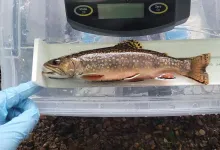(Press-News.org) UNIVERSITY PARK, Pa. — Brook trout may have a genetic trick up their scales when it comes to adapting, with limitations, to heatwaves that threaten their existence. Scientists have known for years that brook trout — an iconic coldwater fish species native to streams and lakes in the eastern United States and Canada — are extremely vulnerable to warming temperatures, with more than half of their habitats characterized as highly sensitive and highly vulnerable to such changes by U.S. Forest Service researchers in 2010. Now, a novel study led by researchers at Penn State suggests that brook trout are capable of mounting a protective genetic response to thermal stress that can be passed on from one generation to the next.
“The responses to heat stress had a high degree of plasticity, with brook trout exhibiting the ability to acclimate and increase tolerance to higher temperatures,” said team leader Jason Keagy, assistant research professor of wildlife behavioral ecology. “Our study covered two heatwaves, and the overall change in expression patterns was more intense during the second heatwave. We think the first heatwave ‘primed’ the response for the second.”
In findings recently published in Science of the Total Environment, the researchers reported that groups of genes involved in immune response and oxygen-conveying activity were upregulated and downregulated, respectively, at higher water temperatures in two successive heat waves in July and August 2022 in four small central Pennsylvania mountain streams.
“Detecting these gene-expression fingerprints of thermal stress allows us to directly ‘ask’ the fish how they are feeling, whether they are stressed out,” Keagy said.
The team closely monitored air and water temperatures and sampled 116 brook trout at eight time points during the heatwaves in each of the four streams. Keagy and his collaborators extracted the fish’s RNA — the genetic material used to build proteins and help regulate biological functions — from their gills without injuring the fish. They sequenced the RNA, a technique that reveals the number of molecules and in what order they appear, and quantified the expression levels of 32,670 unique genetic transcripts, which carry the instructions for proteins essential for cell and tissue function. The team found that overall gene-expression patterns in response to water temperature change were similar among fish in all four streams studied.
The researchers also detected 43 genes that were differentially expressed at different time points and followed the same expression pattern during the two heatwaves. Of these genes, 42 related to water temperature. Some of these differentially expressed genes — including those producing heat-shock proteins and cold-metabolism proteins — have been linked to temperature responses in other studies, the researchers said.
Keagy noted that brook trout begin to experience declines in growth rate in water above 61 degrees Fahrenheit and acute heat stress above 68 degrees Fahrenheit, with critical thermal maximum temperatures reached near 84 degrees Fahrenheit. He explained that the frequency and intensity of extreme weather events is increasing, which is predicted to reduce suitable thermal habitats for brook trout, especially when combined with other environmental changes like land-use that removes forests along streams and the introduction of non-native competitors like brown trout.
“Critically, extreme weather events can be more important drivers of extirpation — state or regional disappearance of a species — and selection than changes in annual or seasonal averages, and they pose a particularly large threat to cold-blooded organisms with body temperatures that fluctuate with their environment,” Keagy said.
Studying the gene response of fish to temperature in nature where conditions are “messy,” rather than in the controlled conditions of a lab was a complicated and challenging endeavor, Keagy pointed out.
“This study was a massive undertaking,” he said. “We identified heatwaves using local weather predictions of air temperature and then tried to capture fish at the beginning, peak, ending and one week after each heatwave. We had no way of predicting how the stream water temperatures would be responding. And yet — led by our talented graduate student Sarah Batchelor, co-author on the paper — we pulled it off quite well. Then, the data analysis was not straightforward — gene-expression studies tend to be much simpler when based in the laboratory — but our lab’s postdoctoral scholar, first author Justin Waraniak, came up with novel and creative ways to analyze the data.”
This study was the one of the firsts test of the emerging field of landscape transcriptomics, recently envisioned by an interdisciplinary team led by scientists in Penn State’s College of Agricultural Sciences. The team, which Keagy leads, hypothesized that it would be possible to collect animals and plants from the wild and determine which stressors they experienced based on specific patterns or signatures in their gene-expression profiles. This is the second landscape transcriptomics paper published this year, with another research group in the college recently publishing on stressors in bumble bees.
“This study shows the utility of landscape transcriptomic approaches to identify important biological processes governing wild organisms’ responses to short-term stressors,” Keagy said. “The results of this study can guide future investigations to identify phenotypic and genetic diversity that contribute to adaptive responses to heatwaves and improve predictions of how brook trout populations will respond to future climate change.”
This research was supported by grants from the Penn State College of Agricultural Sciences Strategic Networks and Initiatives Program and the U.S. Department of Agriculture’s National Institute of Food and Agriculture.
END
Threatened by warming waters, brook trout may be able to adapt to hotter weather
Heatwaves appear to trigger heritable gene expression changes that may help make the fish more tolerant of thermal stress, researchers report in novel study
2025-03-18
ELSE PRESS RELEASES FROM THIS DATE:
AI ring tracks spelled words in American Sign Language
2025-03-18
ITHACA, N.Y. – A Cornell University-led research team has developed an artificial intelligence-powered ring equipped with micro-sonar technology that can continuously and in real time track fingerspelling in American Sign Language (ASL).
In its current form, SpellRing could be used to enter text into computers or smartphones via fingerspelling, which is used in ASL to spell out words without corresponding signs, such as proper nouns, names and technical terms. With further development, the device – believed to be the first of its kind – could revolutionize ASL translation by continuously tracking entire signed words and sentences.
“Many other technologies that recognize ...
What’s behind the ‘pop and slosh’ when opening a swing-top bottle of beer?
2025-03-18
WASHINGTON, March 18, 2025 — In a fun experiment, Max Koch, a researcher at the University of Göttingen in Germany — who also happens to be passionate about homebrewing — decided to use a high-speed camera to capture what occurs while opening a swing-top bottle of homebrew.
When Robert Mettin, who leads the Ultrasound and Cavitation group at the university’s Third Institute of Physics, Biophysics, suggested that Koch should submit the findings to the special “kitchen flows” issue of Physics of Fluids, from AIP Publishing, Koch and his colleagues chose to ...
Adherence to annual lung cancer screening and rates of cancer diagnosis
2025-03-18
About The Study: In this multicenter cohort study of adults undergoing lung cancer screening, screening adherence was associated with increased overall and early-stage lung cancer detection rates; however, adherence decreased annually after baseline screening, suggesting that it is an important lung cancer screening quality metric.
Corresponding author: To contact the corresponding author, Roger Y. Kim, M.D., M.S.C.E., email roger.kim@pennmedicine.upenn.edu.
To access the embargoed study: Visit our For The Media website at this link https://media.jamanetwork.com/
(doi: ...
Geographic access to cancer care and treatment and outcomes of early-stage non–small cell lung cancer
2025-03-18
About The Study: In this cohort study, geographic access to cancer care was associated with guideline-recommended treatment for early-stage non–small cell lung cancer (NSCLC) and outcomes, particularly in socially marginalized patients, underscoring the importance of ensuring appropriate geographic allocations of cancer care resources and addressing travel barriers to health care to improve NSCLC treatment, prognosis, and equity.
Corresponding authors: To contact the corresponding ...
Trauma surgeons propose ‘precision transfusion’ approach to pre-hospital care
2025-03-18
When someone is traumatically injured, giving them blood products before they arrive at the hospital – such as at the scene or during emergency transport – can improve their likelihood of survival and recovery. But patients with certain traumatic injuries have better outcomes when administered specific blood components.
University of Pittsburgh School of Medicine and UPMC scientist-surgeons announced today in Cell Reports Medicine that giving plasma that has been separated from other parts of donated blood improves outcomes in patients with traumatic brain injury (TBI) or shock, whereas giving unseparated or “whole” ...
New artificial intelligence tool accelerates disease treatments
2025-03-18
University of Virginia School of Medicine scientists have created a computational tool to accelerate the development of new disease treatments. The tool goes beyond current artificial intelligence (AI) approaches by identifying not just which patient populations may benefit but also how the drugs work inside cells.
The researchers have demonstrated the tool’s potential by identifying a promising candidate to prevent heart failure, a leading cause of death in the United States and around the world.
The new AI tool called LogiRx, can predict how drugs will affect biological processes in the body, helping scientists understand the effects the drugs will have ...
CCA appoints expert panel on enhancing national research infrastructure
2025-03-18
Canada’s research infrastructure is essential to the future of science and innovation, economic prosperity, and well-being throughout the country. At the request of Innovation, Science, and Economic Development Canada, the CCA has formed an expert panel to support the federal government in optimizing Canada’s research infrastructure—from its national-scale scientific facilities to its digital platforms and collaborative networks—through evidence synthesis and strategic insights. Janet King, Chair of Polar Knowledge Canada’s Board of Directors and Vice-Chair of the Canadian Light Source’s Board of Directors, will serve ...
Rising Stars: PPPL researchers honored in 2024 Physics of Plasmas Early Career Collection
2025-03-18
Celebrating fresh thinking in plasma physics is essential to the continued growth of the field, and this year’s Physics of Plasmas Early Career Collection highlights some of the most promising new voices pushing the boundaries of discovery.
The prestigious collection highlights top papers from all areas of plasma physics research authored by individuals who defended their dissertations within the past five years. This year, three researchers at the U.S. Department of Energy’s Princeton Plasma Physics Laboratory (PPPL) are featured in the Early Career Collection:
Staff Research ...
Add some spice: Curcumin helps treat mycobacterium abscessus
2025-03-18
Highlights:
Mycobacterium abscessus can cause dangerous lung infections.
Treatment usually requires a combination of antibiotics for more than a year.
Researchers in China report that curcumin, found in turmeric, can enhance treatment with bedaquiline, an antimycobacterial.
Animal studies showed that treatment with the combination led to a faster clearance of the infection.
Washington, D.C.—Mycobacterium abscessus is a fast-growing, pathogenic mycobacteria that can cause lung infections, and people who have respiratory conditions or are immunocompromised ...
Coastal guardians pioneer a new way to protect the Florida Keys’ shorelines
2025-03-18
By 2050, sea levels along the United States coast are expected to rise by 0.25 to 0.30 meters, increasing flooding in low-lying areas. Due to its unique geography and infrastructure network, the Florida Keys is particularly at risk of climate hazards such as sea level rise, hurricanes and flooding. Since 2015, the Florida Keys has experienced four hurricanes – Irma (2107), Ian (2022), Helene (2024) and Milton (2024).
Nature-based solutions, such as restoring mangroves and coastal strands, can help mitigate these risks by stabilizing shorelines, improving ecosystems ...
LAST 30 PRESS RELEASES:
How the parasite that ‘gave up sex’ found more hosts – and why its victory won’t last
When is it time to jump? The boiling frog problem of AI use in physics education
Twitter data reveals partisan divide in understanding why pollen season's getting worse
AI is quick but risky for updating old software
Revolutionizing biosecurity: new multi-omics framework to transform invasive species management
From ancient herb to modern medicine: new review unveils the multi-targeted healing potential of Borago officinalis
Building a global scientific community: Biological Diversity Journal announces dual recruitment of Editorial Board and Youth Editorial Board members
Microbes that break down antibiotics help protect ecosystems under drug pollution
Smart biochar that remembers pollutants offers a new way to clean water and recycle biomass
Rice genes matter more than domestication in shaping plant microbiomes
Ticking time bomb: Some farmers report as many as 70 tick encounters over a 6-month period
Turning garden and crop waste into plastics
Scientists discover ‘platypus galaxies’ in the early universe
Seeing thyroid cancer in a new light: when AI meets label-free imaging in the operating room
Neutrophil-to-lymphocyte ratio may aid risk stratification in depressive disorder
2026 Seismological Society of America Annual Meeting
AI-powered ECG analysis offers promising path for early detection of chronic obstructive pulmonary disease, says Mount Sinai researchers
GIMM uncovers flaws in lab-grown heart cells and paves the way for improved treatments
Cracking the evolutionary code of sleep
Medications could help the aging brain cope with surgery, memory impairment
Back pain linked to worse sleep years later in men over 65, according to study
CDC urges ‘shared decision-making’ on some childhood vaccines; many unclear about what that means
New research finds that an ‘equal treatment’ approach to economic opportunity advertising can backfire
Researchers create shape-shifting, self-navigating microparticles
Science army mobilizes to map US soil microbiome
Researchers develop new tools to turn grain crops into biosensors
Do supervised consumption sites bring increased crime? Study suggests that’s a myth
New mass spec innovation could transform research
Maternal nativity, race, and ethnicity and infant mortality in the US
Migration-related trauma among asylum seekers exposed to the migrant protection protocols
[Press-News.org] Threatened by warming waters, brook trout may be able to adapt to hotter weatherHeatwaves appear to trigger heritable gene expression changes that may help make the fish more tolerant of thermal stress, researchers report in novel study







